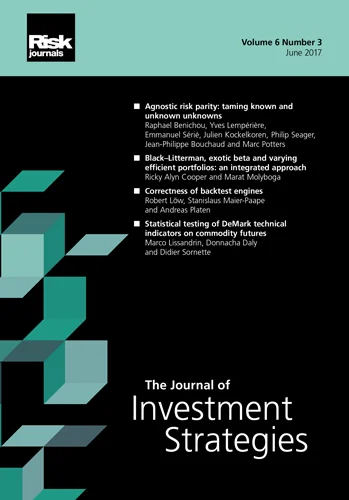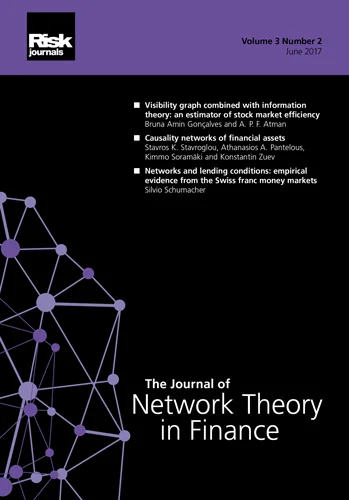Journal of Energy Markets
ISSN:
1756-3615 (online)
Editor-in-chief: Kostas Andriosopoulos
Volume 14, Number 1 (March 2021)
Editor's Letter
Derek W. Bunn
London Business School
Carlo Lucheroni
University of Camerino
This issue of The Journal of Energy Markets is a specially selected and reviewed compilation of papers from the fourth annual conference of Energy Finance Italia (EFI), EFI4, held in 2019 at the University of Milano Bicocca. EFI’s series of international conferences gathers together academic researchers and practitioners from Italy and abroad who are interested in theoretical and applicative aspects of energy issues, especially those with interdisciplinary approaches covering mathematics, physics, engineering, law, finance and economics (see http://energyfinanceitalia.unicam.it/index.php/about), as well as problems related to renewable energy and sustainability.
About 20 papers were discussed in person at EFI4, from which we have selected the four papers in this issue. They share a common theme: the generation and consumption of electricity, studied in a quantitative way. The data sets used in all four cases are time series. The investigation tools span machine learning, functional methods, information theory and game theory. All four papers went through the regular Journal of Energy Markets refereeing process, under the standards set by the journal.
In “Neural network middle-term probabilistic forecasting of daily power consumption”, our first paper, Roberto Baviera and Michele Azzone build up and discuss a new probabilistic autoregression model called NAX, designed to forecast the relationship between electricity consumption and temperature in the middle term (from a few months up to one year). In a clever setup, they are able to use a recurrent neural network to forecast a Gaussian marginal distribution in the mid-future for consumption by forecasting its mean and variance parameters. The network feeds itself with these parameters and associates them with the temperature. The authors apply this setup to the consumption residuals of a general linear model (to separate seasonality and trend) running in time along the series. Since neither future time series (consumption or temperature) is known at forecasting time, the authors evaluate the model using the Hyndman and Fan ex post forecasting evaluation framework in order to separate out the effect of temperature uncertainty on model structure from the evaluation. They assess the quality of their consumption forecasts by using point and probabilistic metrics, and by checking the sharpness and the robustness of the probabilistic forecast.
“The selection of predictive variables in aggregate hydroelectric generation models” is the second paper in this issue. In it, Claudia Condemi, Loretta Mastroeni and Pierluigi Vellucci study the problem of understanding how production, environmental and economic/financial variables interact in time in relation to electricity generation as part of the hydroelectric-plus-storage plants sector in Northern Italy. The authors assume that the main features of production decisions in hydroelectric-plus-storage plants are linked to the hybrid role of these plants, which are fueled by nondispatchable (renewable) energy but can be dispatched based on their storage availability. The chosen statistical tool is entropic analysis from information theory, and specifically cross-entropy rates. The reciprocal relationships among aggregated generation and environmental variables (like rainfall and snowpack level) and economic/financial variables (like spot and forward prices of electricity and natural gas) are discussed using the chosen tools.
In our third paper, “Optimal electricity distribution pricing under risk and high photovoltaics penetration”, Maxim Bichuch, Benjamin Hobbs, Xinyue Song and Yijiao Wang model the interaction between a regulator, which can decide the price tariffs, and a pool of prosumers, which can decide to invest in photovoltaic power plants for self-production. This setup results in a bilevel Stackelberg (or leader-follower) game, with the regulator as leader and the consumers as followers. The consumers, given the price tariffs, must find a Nash equilibrium among themselves for their optimal photovoltaic installation that maximizes their utility function. Under the assumption that the consumers’ demand is mean-reverting, the paper shows that the consumers’ game has a Nash equilibrium for each given tariff; the global game between regulator and consumers has an equilibrium as well. The authors present numerical results based on PJM power market data that show that photovoltaic installation increases when market demand is more volatile.
Mariia Soloviova and Tiziano Vargiolu present a new, efficient way of representing demand and supply curves in day-ahead power market auctions in “Efficient representation of supply and demand curves on day-ahead electricity markets”, the issue’s final paper. In principle, these curves are built by aggregating thousands of bids; thus, the dimensionality needed to describe them exactly is very high. The method presented in this paper is based on a clever use of integrals of radial basis functions. Based on IPEX market data spanning one year, the authors show numerically that a very limited number of basis functions is necessary to obtain a very good approximation of the bid and ask curves observed during the observation year, and consequently of the closing price. The paper also tests this method for price forecasting against existing models. The result is that the proposed functional method outperforms classical seasonal autoregressive models based only on closing prices in terms of most summary error measures.
Papers in this issue
Neural network middle-term probabilistic forecasting of daily power consumption
The authors propose a new modeling approach that incorporates trend, seasonality and weather conditions as explicative variables in a shallow neural network with an autoregressive feature.
Efficient representation of supply and demand curves on day-ahead electricity markets
The authors model the supply and demand curves of electricity day-ahead auctions in a parsimonious way by building an appropriate algorithm to present the information about electricity prices and demand with far fewer parameters than the existing…
The selection of predictive variables in aggregate hydroelectric generation models
This paper provides a method to identify the best predictive variables and the appropriate predictive indexes for an aggregate hydropower storage forecasting model. To this end, we use an entropy-based approach.
Optimal electricity distribution pricing under risk and high photovoltaics penetration
The authors model a hierarchical Stackelberg game in a competitive power market under high behind-the-meter photovoltaics penetration and demand-side uncertainty, with emphasis on the feedback loop between distributed generation via photovoltaics and…








